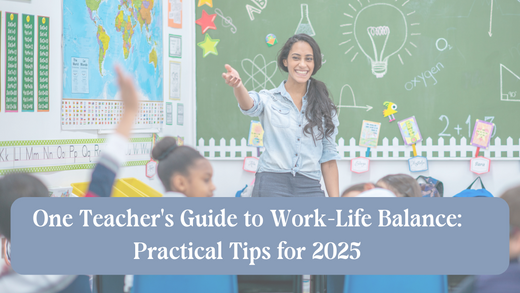
One Teacher's Guide to Work-Life Balance: Practical Tips for 2025
By Aimee Shattock
If you’re starting the year feeling stressed about the year ahead, you’re not alone. While Instagram may be filled with excited teachers decorating their classrooms and preparing their teacher outfits for 2025, many teachers are feeling overwhelmed at the prospect of another year where the job seems to take over their life. If that’s you, you’re not alone, you’re not a bad teacher, and you’re in the right place.
My name is Aimee, and I’m heading into my tenth year of teaching—a job I absolutely love. But for years, I struggled to balance my passion for teaching with my own wellbeing, often letting work take over my life. This year, I’m committed to doing things differently and achieving a healthier work-life balance. Here are the things I’ve learned about how to get better balance in this incredible job, and how to do the job well without losing yourself in the process.
1. Let go of perfection
The perfect teacher in your head doesn’t exist, and even if you became this person, there would still be students who prefer a different approach. And that’s a good thing! Students don’t want perfection; they want a teacher who shows up as their authentic self, shares their infectious passion for learning, connects with students and builds their confidence. That’s it. There are plenty of ways to get better at the craft of this job, and I absolutely encourage improvement and learning, but if it’s perfection that’s driving you, stop it.
2. Focus with the 80/20 rule
The 80/20 Rule (or Pareto Principle) is a game changer for busy (and overwhelmed/exhausted/burnt-out) teachers. It captures the idea that 80% of your success often comes from 20% of your efforts. So, instead of trying to overhaul everything and loading up your teacher planner with ALL your ideas and ambitions for the year ahead, focus on the 20% of strategies and systems that will give you the biggest return on your time and energy.
Questions to ask yourself here:
● What teaching practices have the most impact on student outcomes and your workload?
● What small changes will make a BIG difference in how you manage your time?
If you’re looking for some evidence-based ideas, I love the Victorian High Impact Teaching Strategies because they make sense, they work in any year level and subject area, and they include effect sizes for impact in the classroom.
3. Get organised
Being organised is one of the best things you can do to improve your work-life balance. Research shows that people who plan their tasks are 20-25% more productive than those who don’t (Mackenzie, 1997).
Personally, even though my curriculum and LMS are online, I use a teacher planner to stay organised day-to-day.
Here are just some of the ways I use my planner:
● Create a personalised term calendar with events, deadlines and assessments
● Plan out my non-teaching lessons
● Write down last-minute changes (eg. room changes and swapped yard duties)
● Take meeting/PL minutes and track actions (and due dates)
● Track where each class is up to in my curriculum
● Write reminders for each lesson (eg. remember x resource, catch up with x student)
● Schedule 1:1 feedback sessions with students
I also leave my planner on my desk at school as a physical reminder to leave work at work.
4. Ditch goals; use systems instead
According to productivity legend, James Clear (2018), ‘You do not rise to the level of your goals. You fall to the level of your systems.’ I’ve realised that I’m great at setting goals, but terrible at using systems. So here are some systems I’m using this year to work smarter, not harder:
Time blocking:
● Use your planner to set specific blocks of time for emails, planning, marking, and admin rather than responding to everything as you go.
● Time-blocking streamlines your workflow and reduces the cognitive load of switching between different activities (Baumeister, 2011; Pashler, 1994).
The daily big-3:
● At the start of each day, write down the ‘big 3’ tasks you need to get done that day and add the rest of your tasks to your weekly to-do list.
● Focusing on fewer, high-priority tasks increases productivity and reduces decision fatigue (Baumeister & Tierney, 2011).
Term-mapping:
● Create your own term calendar to map out deadlines and high-demand times (e.g., reports). Then, create weekly priorities in advance of the deadlines (eg. finish first draft of reports).
● Advanced planning reduces stress and improves time management during peak periods (Britton & Tesser, 1991).
1:1 student conferencing:
● Schedule one-on-one catch ups with students each lesson to touch base, look at their work and give them verbal feedback rather than taking mountains of books home each day.
● Personalised feedback helps improve student performance and motivation (Hattie, 2009).
I hope these tips help the year ahead feel less overwhelming and more sustainable for you. Teaching is an incredible job, but it’s also demanding, and finding the right balance takes effort and intention. The best thing you can do for yourself this year is to focus on the strategies that truly make a difference—for your students and yourself—and let go of the rest.
Aimee is a guest author for Luxe Learning Hub. She’s an AITSL-Certified Lead Teacher who teaches high school English in Melbourne, and she’s also the founder of Base Planners - a teacher planner company that focuses on creating practical solutions and systems for busy teachers. You can find Base on Instagram, Facebook and Tiktok, and you can check out their 2025 Base Teacher Planner here.

